HSVPOA Helps to Manage Local Bear Population
A couple of years ago, black bears were observed roaming and foraging in Hot Springs Village. They seemed to enjoy the generosity of plentiful seed portions in bird feeders and sugar water found in hummingbird feeders. The whole community was abuzz with excitement and or fear, depending on one’s perception of these beautiful and magnificent creatures. Many Villagers reported sightings on social media and numerous photographs were uploaded as proof. Click here to read a little about this and to watch a short video clip.
At that time, Hot Springs Village POA, Wildlife Manager, Todd Noles, worked closely with Arkansas Game and Fish in order to encourage the encroaching bears to relocate to more remote areas. In an ongoing effort and reciprocal agreement with the Arkansas Game and Fish Commission Noles continues to assist with monitoring the bear population in the surrounding area.
Janet Rowe, President of the HSV Audubon Society, first became interested in the Bear Population and Den Study when a Game and Fish Veterinarian, Jenn Ballard, gave a presentation at a recent Audubon meeting. The vet told the organization that Arkansas Game and Fish performs yearly checks on the female bears (sows) when they are in the dens for the winter. Janet was able to accompany the team when they studied a local bear den.
A Spectacular Day!
Janet described the day as “spectacular!” For most people, this experience would be a unique and unparalleled event, and for Janet, it was no different. Janet has led an interesting life so far, as a retired law enforcement officer for the Arlington County Police Department, and she has experienced a lot of different situations, but never before has Janet visited a bear den.
Janet, a nature lover to her very core, appreciates most creatures small and large and the Arkansas black bear is no exception. Janet was afforded the opportunity of accompanying the Arkansas Game and Fish folks and HSV’s very own Wildlife Manager, Todd Noles, while the team performed a routine check on a hibernating sow. This is a yearly procedure performed by Game and Fish and helps them to keep a record of the health, size, and location of the bear population. The Arkansas Game and Fish Commission are able to locate the dens of female bears through radio-tracking devices.
Barely any Bears Left
In the 1700s and 1800s, bears were hunted for their fat and almost became extinct in Arkansas. It was nearly too late by the time the state intervened, but in the 1920s Arkansas made bear hunting illegal. In 1958, the Game and Fish Commission, with the help of Minnesota and Manitoba, Canada, began importing 254 bears over a ten-year period of time to overcome the extreme loss of the Arkansas bear population.
At that time, as few as three or four dozen bears remained in southeast Arkansas in the bottomlands where the White and Arkansas Rivers meet the Mississippi. Since that time period, the bears have managed to increase their numbers to an estimated 6,000 bears.
Considering there were less than a few dozen bears in Arkansas at one time, this is one of Wildlife Management’s most incredible success stories.
“No other natural resource agency has ever reintroduced a large carnivore as triumphantly as Arkansas Game and Fish Commission. It’s considered the most successful reintroduction of a large carnivore in history, not just in Arkansas or the United States, but around the world.”
Arkansas black bears inhabit three distinct areas in Arkansas, Black bears reside in the Ozarks and Ouachitas Ranges as well as the lower White River areas. These three bear populations tend to stay separate from each other.
Mama Bear and Her Cubs
The den that Janet and the team visited on this day was located in the Ouachita Mountains. Mama Bear had dug out her cozy den from under the root ball of a fallen tree.
The weather cooperated perfectly. The workers and observers made their way down an old service road through the beautiful mountain forest to locate the den. Janet said she rode in the bed of a pickup for this part of the trip. The group was fortunate in that they only had to trek about 800 feet on foot. According to Myron Means, Arkansas State Bear Biologist, accessing the den can sometimes be an arduous task as experienced mamas prefer to birth their cubs in very remote, hard-to-access areas. “Typically they are down in deep ravines…,” stated Means.
Bears don’t truly hibernate. While sleeping deeply, they can also arouse immediately. When a research team approaches the den, Mama Bear wakes up and is always cognizant of what is happening. “Some are more aware than others,” explained Means.
Bears enter the den cycle in mid-November and during this cycle will not eat, drink, defecate or urinate for four to five to five months.
Medical Team Goes to Work
Upon arrival at the den area, the medical team approached first. The sow was tranquilized. It typically takes ten to twenty minutes for the sedation to work. Once sedation of Mama was successful, the medical team called the rest of the group to the site.

After making sure the sow was sedated, her tongue was pulled out of her mouth to keep her airway open. She was put on oxygen and her oxygen levels were monitored the whole time. Large band-aids were carefully placed over her eyes to keep out debris and maintain eye moisture. Additionally, the bandages helped to keep the mother calm.

A thorough examination of the cubs was conducted, including, weight, measurements body length, chest circumference, and foot size. Color and markings were also noted. The adult female was also given a thorough examination.
Janet shared that the den contained three six-week-old nursing cubs, two females, and one male. One of the females was cinnamon, sporting lovely reddish-brown colored fur. The cinnamon female was the largest of the triplets with the male being the smallest.
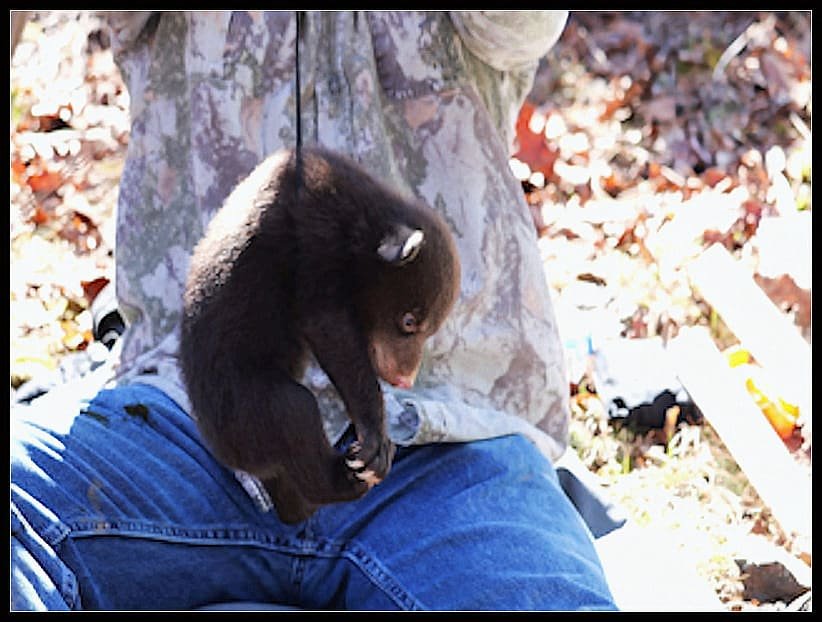
Janet enthusiastically explained that she and some of the others were permitted to hold the bear cubs. Janet said, “They were so sweet and made cute little gurgling noises. The cubs loved being held and in the warm sunlight became very sleepy.” Janet said she was surprised that the cubs did not smell musky and the den appeared clean.
After the examination and cuddling, the cubs were placed back in the den with their mother. The whole process took around two hours.
Janet shared that she was impressed and was glad she got to see exactly what Vet Ballard talked about in her presentation to the Audubon Society meeting. Janet will share her experience with the Audubon group.
The furry threesome will soon be entering the larger world with their mother in April. Remaining with Mama for two den cycles, she will watch over and teach her children the intricacies of the bear world. After the second den cycle, the males are kicked out to lead their own lives, but Mama lets the females stay in her home range. While the story of Arkansas bears almost had a tragic ending, it is now a stellar example of successful wildlife management, thanks to the efforts of the Arkansas Game and Fish Wildlife Managers.
Arkansas Bear Facts
- Means said, “it is thought at the time of pre-settlement that Arkansas had as many as 50,000 black bears in the state. We were unofficially named the “Bear State”.
- On average, Arkansas Black bears give birth to two cubs every other year with a gestation period of only around 65 days. Cubs are born in January, weighing a half pound or less and gain about a pound per week until emerging from the den with their mother in April.
Forester, Todd Noles has faithfully served the Hot Springs Village POA for 28 years. He is in charge of all issues relating to forestry, wildlife, and common property.
Jennifer Ballard is the state wildlife veterinarian for the Arkansas Game and Fish Commission. She says, “The mission of the AGFC is to conserve and enhance Arkansas’ fish and wildlife and their habitats while promoting sustainable use, public understanding, and support. I serve two roles in the agency. As a veterinarian, I advocate for management approaches that will benefit the health of our state’s fish and wildlife populations. I also serve as assistant chief of our research division.”
Myron Means is the Large Carnivore Program Coordinator (Biologist for the Arkansas Game and Fish Commission). Biologist Means is a respected authority on bears in Arkansas and has been working for the AR Game and Fish Commission for over two decades.
Biologist Myron Means on Arkansas Black Bears and an Actual Den Visit
✾ ✾ ✾
Photography Courtesy of Janet Rowe
CHERYL DOWDEN, Hot Springs Village People Gazette, March 22, 2022
✾ ✾ ✾
We are glad you dropped in to visit Hot Springs Village People Gazette. If you like, please comment below; we love to hear your opinions. Thank you for keeping the comments polite and on topic. Please use your first and last real name. We promote local businesses, events, and organizations! Let us know if we can help. We also accept opinion pieces and articles from guest authors. We can be contacted through this website; just click the contact button and let us know what’s on your mind. Be sure to bookmark this site and come back to visit with us often as our content is frequently changing. If you are an HSV Property Owner, click here to visit and join a private Facebook Group.
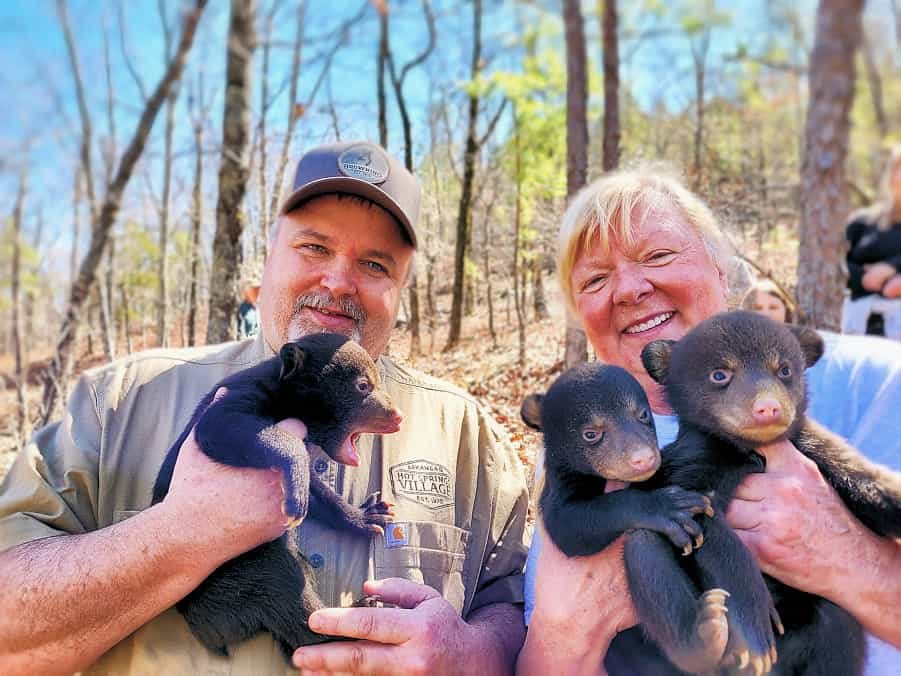

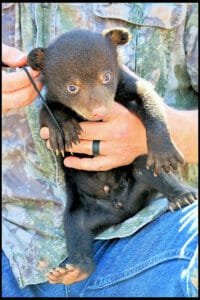
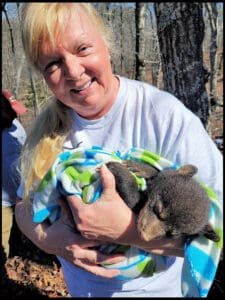
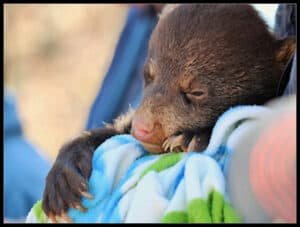



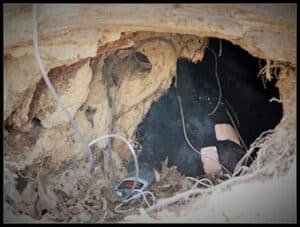
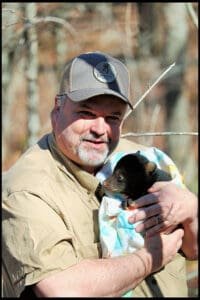










Marcia McMichael
03/22/2022 — 8:18 am
AMAZING! ! All the historical details of Arkansas bear populations: personal & professional profiles of the wildlife conservation team members; exciting description of visiting the den; and great heart-melting photo exhibits – ALL ARE AMAZING!! Thank you for sharing this wonderful follow-up story to the prior bear visits to HSV.
HSVP C
03/22/2022 — 9:01 am
It was our pleasure, Marcia. Thank you for reading.
Linda Overton
06/01/2023 — 12:58 pm
Is the Cortez area still in bear alert or can we invite our birds back? I miss them.